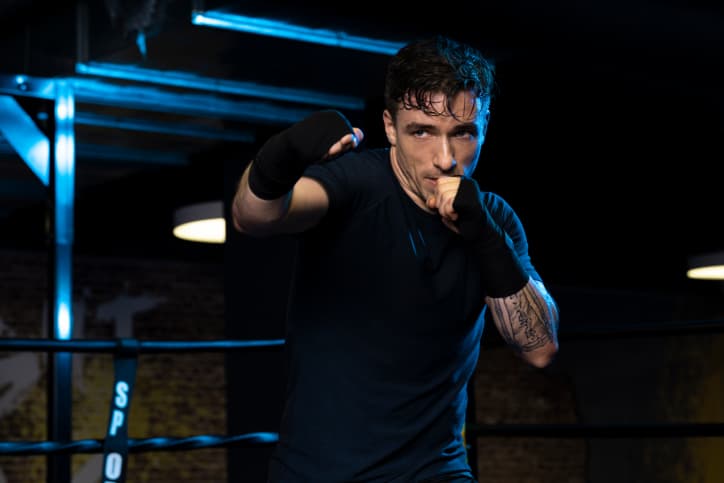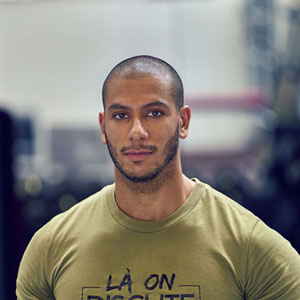Comment faire du sport et adapter ses entrainements lorsqu’il fait chaud ?
Nous y voilà ! La saison des grosses chaleurs et des journées ensoleillées ! Peut-être que tu as attendu l’été avec impatience cette année et ça se comprend tout à fait. Tu vas pouvoir profiter du soleil, mais il faudra aussi être vigilant à prendre les bonnes dispositions lorsque tu t’entraînes. Et oui ! S’entraîner lorsqu'il fait chaud demande d’être attentif à certains facteurs de la même façon qu’il faut l’être en hiver (pour des raisons différentes). Dans l’article d’aujourd’hui, je vais t’expliquer en détail pourquoi et comment il faut parfois adapter ses entraînements lorsqu'il fait chaud.
Dans un premier temps, nous avons besoin de faire la distinction entre plusieurs “types” d’entraînements ainsi que les endroits où ils vont être pratiqués :
● L’entraînement en salle de sport
● L'entraînement en extérieur
● L’entraînement cardio
● L’entraînement renforcement musculaire
Tu imagines bien que les précautions ne seront pas les même lorsque tu t’entraînes en salle avec une séance de musculation et en extérieur avec 1h de cardio à intensité modérée ou un circuit HIIT. C’est donc dans ces cas de figure qu’il va falloir adapter ses séances pour ne pas subir une baisse de performances ou pire, une petite blessure…
La déshydratation est plus importante lorsqu’il fait chaud
Lorsque les températures augmentent, tu t’exposes à deux risques. Le premier est évidemment la déshydratation par la transpiration. Tu ne connais peut-être pas le mécanisme derrière la transpiration, mais lorsque les températures augmentent trop, ton corps va réguler sa propre température en provoquant une sudation plus ou moins importante. Cette sudation va permettre une baisse de la température de ton organisme qui je te le rappelle doit rester autour des 37°. Ce phénomène, qui est vital lorsqu’il fait trop chaud, s’accompagne donc d’une évaporation d’eau (et de toxines / bactéries) ce qui entraîne forcément une déshydratation.
Le problème, parce qu’il y en a un, c'est que l’effort physique provoque aussi une augmentation de la température du corps ! Tu risques donc d’évacuer beaucoup plus d’eau lorsque tu t’entraînes et qu’il fait chaud. Même si la “gravité” de ce phénomène varie en fonction des individus (certains transpirent plus que d’autres), nous sommes tous exposés à un risque de déshydratation.
Tu l’imagines bien, être déshydraté pendant une séance de sport n’est absolument pas recommandé et peu même être dangereux. J’ai d’ailleurs fait un article il y a quelque temps sur les risques associés à la déshydratation que je t’encourage à lire aussi vite que possible. Ceci dit, aujourd’hui, il n’est pas question d’expliquer ce que tu risques lorsque tu es déshydraté. Il s’agit plutôt de voir quelles sont les solutions et les habitudes à prendre pour adapter ses entraînements.
La perte de différents minéraux
Mais avant cela, il faut quand même aborder le deuxième risque auquel tu t’exposes lorsque tu t’entraînes par forte chaleur. Celui de “perdre” ou plutôt d’évacuer avec la transpiration, des quantités non négligeables de minéraux comme le sodium, le magnésium, le zinc ou même le potassium. Dans le cadre d’une séance de musculation ou de cardio lorsqu'il fait chaud, c’est surtout les pertes de sodium qui doivent être surveillées et qui risquent d’être réduites par une transpiration abondante.
Comment faut-il s’y prendre pour adapter ses entraînements ?
Premièrement, il faut déjà que tu saches avec quelles activités tu es le plus “à risques”. Les séances de musculation faites en intérieur sont celles qui t’exposent le moins à la déshydratation. Bien sûr, cela dépend si la salle en question est climatisée ou non. Ensuite, nous avons les séances de cardio réalisées en intérieur. Puis, les séances de musculation ou de renforcement musculaire réalisées en extérieur et enfin les séances de cardio ou de circuit HIIT réalisées en extérieur.
Tes besoins en eau et en sodium seront donc évidemment différents en fonction de l’activité et de l’endroit où tu vas pratiquer. Sois donc bien attentif aux conditions dans lesquelles tu t’entraînes.
S’hydrater en augmentant la quantité d’eau pendant l’entrainement
La première adaptation en cas de forte chaleur est bien sûr de s’hydrater correctement ! C’est logique et évident, mais tu ne réalises pas à quel point les quantités de transpiration peuvent être importantes lorsque les températures augmentent. En temps normal, un adulte transpire jusqu’à 1 litre de sueur par jour. En cas de forte chaleur et d’activité physique intense, ce chiffre peut-être multiplié par 10 ! Oui tu as bien lu, 10 litres de transpiration par jour. Alors effectivement, des quantités aussi importantes correspondent à des efforts très longs, mais il n’est pas impossible que tu évacues plus de 5 litres de sueur lorsque tes séances sont intenses. Lorsqu’on part du principe qu’un adulte doit consommer en moyenne environ 2 litres d’eau par jour dans des conditions normales (température moyenne et activité modérée), si on prend en compte les températures et l’effort physique, tes apports peuvent tout à fait être doublé ou triplé. Ces valeurs sont bien entendu à mettre en relation avec ton poids de corps, mais tu comprends bien à quel point il est capital de consommer assez d’eau dans la journée.
Il faut donc veiller à s’hydrater toute la journée et bien sûr avant, pendant et après un effort physique intense. Si tu n’es pas habitué à boire autant d’eau, commence doucement avec des quantités que tu “supportes” avant d’augmenter petit à petit en fonction des températures extérieures et de l’intensité de ton effort. Pas la peine de partir dans des extrêmes et d’essayer de boire un litre d’eau toutes les deux heures ! La seule chose que ça pourrait t’apporter c’est de faire des allers-retours constants aux toilettes pour évacuer l’excès de liquide. Écoute simplement ton corps et fais les changements nécessaires en fonction de ton état.
Avoir une consommation suffisante en sodium
Le deuxième conseil, qui va te sembler étrange, est d’avoir une consommation suffisante de sodium. Pourquoi ce conseil peut paraître étrange ? Car on entend à longueur de journée des recommandations du type “Ne mangez pas trop sucré, trop gras ou trop salé”. Ces recommandations sont très importantes pour les personnes sédentaires, mais pour les sportifs, c’est un peu différent. Si tu limites volontairement tes apports en sodium, tes performances vont en souffrir. Si on ajoute à ça des températures élevées et une sudation importante, tu risques très certainement d’évacuer de trop grandes quantités de sodium. En plus de ça, il semblerait que dans la communauté “musculation”, le sodium est très souvent diabolisé, car responsable (à tort) de la rétention d’eau… Ne fais surtout pas l’erreur de supprimer le sel ou de réduire dangereusement ta consommation.
Si actuellement, ton alimentation est principalement constituée d’aliments bruts et non transformés, alors il est tout à fait possible et même bénéfique de rajouter du sel à certains de tes repas si tu en ressens le besoin. Par contre, plus ton alimentation sera constituée d’aliments transformés, plus tu devras être vigilant à ta consommation de sodium. Dans ces cas, il serait plus sage de ne pas rajouter de sel à tes repas.
Pendant un effort physique et lorsque les températures sont élevées, il est tout à fait possible de consommer une boisson pour l’effort chargé de minéraux et d’électrolytes. Cette boisson te permettra non seulement de rester hydraté, mais aussi de restocker tes réserves de sodium et d’autres minéraux également. Vérifie bien que cette boisson contient effectivement du sodium et non pas uniquement du sucre si tu ne veux pas avoir l’effet inverse.
Adapter l’intensité des séances
Pour le corps de ta séance, tu devras aussi faire quelques modifications pour éviter de t’épuiser trop rapidement et de compromettre ta capacité de récupération.
● Tes séances ne devront pas être trop longues. En règle général, tu devrais avoir le temps de faire une excellente séance en 1h. Si jamais tu as besoin d’1h30, c’est probablement que la structure de ton programme mérite d’être adaptée.
● N’utilise pas trop de technique d’intensification. Les superset et les séries dégressives c’est agréable ! Mais c’est aussi épuisant. Il faut donc faire attention à ne pas en utiliser plus que nécessaire. Conserve l’utilisation de ces techniques les jours où les températures ne sont pas trop élevées.
● Ne réduis pas trop tes temps de récupération. Même logique que les techniques d’intensification ! Même si tu as l’impression de “mieux travailler” en récupérant une trentaine de secondes, c’est d’une part potentiellement moins efficace pour la prise de muscle, mais aussi épuisant lorsque les températures augmentent. Il vaut mieux conserver un format d’entraînement où les récupérations sont moyennes à longue (entre 1min30 et 3min selon les exercices)
● Mais surtout, écoute ton corps ! Les grosses chaleurs peuvent réellement te mettre dans un état de fatigue important. Si tu te sens plus “faible” certains jours, prends les dispositions nécessaires et réduis l’intensité de ta séance. Tu peux supprimer un ou deux exercices sans problème et sans que l’efficacité de ta séance ne soit compromise. Ne cherche pas à battre des records si les conditions ne sont pas bonnes !
Avec ces conseils, tu vas pouvoir performer tout l’été en adaptant certaines choses. Je te fais confiance pour appliquer au mieux les recommandations que je viens de te partager. Bon courage ;)
 Offre spéciale : Les 4 premières semaines à 19€
Offre spéciale : Les 4 premières semaines à 19€




